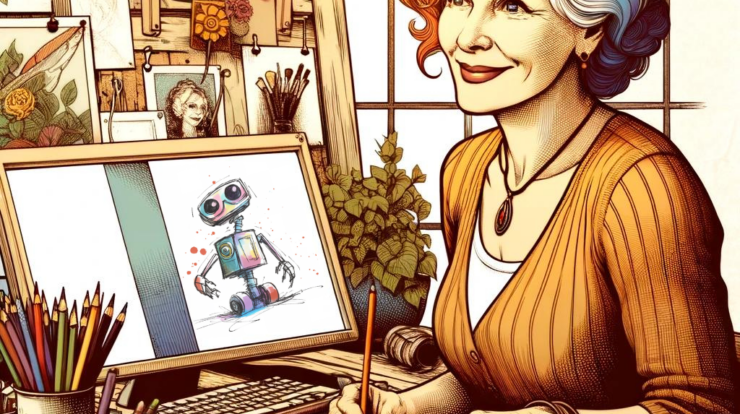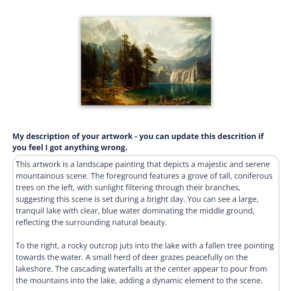
As someone deeply ingrained in the art world, I’ve seen firsthand how technology can be a game-changer. I witnessed the advent of the internet, online galleries, and social media. Today, I want to talk about AI, a tool reshaping how we, as artists and gallery owners, approach the creative and business aspects of art.
I’ve always tried to stay on point with new technologies that can help us better serve artists and our clientele, and when I first saw AI gaining momentum, I knew it merited exploration.
AI as a Helpful Assistant
My journey with generative AI began as an experiment, a foray into the unknown. I started viewing AI as a helpful assistant, a tool to enhance my creative output and efficiency. I learned quickly that AI isn’t a magician that conjures up content from thin air. Instead, it’s a collaborator that needs guidance – your ideas, style cues, and creativity. And when provided with these, it can assist remarkably well.
I’ve used AI in the gallery to craft compelling social media ads, brainstorm email subject lines, and draft client emails. The results? A more streamlined process and messages that still carry my voice and thoughts, albeit refined with AI’s efficiency.
I’ve been so pleased with the results that I wanted to share the AI abilities that have streamlined our business with artists.
Introducing Theobot: A Tailored AI Tool for Artists
I’m thrilled to introduce you to Theobot.ai – an AI writing tool we’ve been developing specifically for artists. This tool encapsulates everything we’ve learned about AI over the past two years. It’s designed to help artists write more effectively in a simple, clean, and straightforward interface, and I’m excited by what it can do.
Theobot is exceptional at analyzing and describing the artwork. Watching it interpret an image and articulate a description is almost like witnessing magic. One user shared with me,
I have three friends […] with art and technical writing backgrounds. The two that got back to me both thought the write-up gave them a new and more informed perspective of the work. What more could I want? I realized that I have been doing geometric abstraction since 1973 and when working in the media […] a lot of what I do is spontaneous and relies on this 50 year background[.] So when I read what the AI says about the piece I was somewhat amazed. It made me feel like AI knew why I constructed the pieces and the color. This process has become so innate to me that I now realize that I could not explain it until Theobot did.”

But Theobot’s prowess doesn’t end there. It’s also a whiz at brainstorming titles, crafting website descriptions, and composing blog posts and email newsletters. Need help responding to emails or writing your artist’s statement and biography? Theobot has got you covered.
A Special Offer for RedDotBlog Readers
I understand some artists have reservations about integrating AI into their art practice. The concerns about the ethics and implications are valid, and I hear them. However, AI is set to transform our world, and we have the choice to harness its potential to enhance our art businesses.
Many artists are already utilizing AI, gaining a competitive edge. I invite you to experience Theobot with a five-day free trial by visiting Theobot.ai. We’re also offering a special introductory price for RedDotBlog readers of just $5/month or an even better deal at $48/year.
This isn’t just about keeping up with technology but embracing tools that open new avenues for creativity and business efficiency. As artists, creativity is paramount– AI is here to amplify that, not replace it.
Your thoughts and experiences are invaluable – let’s discuss them in the comments below.
How are you using AI in your art practice? Are you ready to let technology be your ally in this ever-evolving art world? Share your thoughts and experiences in the comments section below.
I love using AI to help me visualize my composition ideas before putting paint to canvas. I’ve discovered that using it to help me with exhibition proposals, artwork descriptions, posts, and using the image generator for ideas has become a vital part of my practice. It isn’t a shortcut or cheating, it’s just a tool to make my life as an artist easier.
I was one of the first to sign up after trying it once. It has been incredibly helpful in creating copy that is in my head but have hard time getting to paper. With my guildance it has become an incredible tool that has made my life easier and being an artist with a thriving business I’ll take any help I can get. Thank you for sharing with us and always trying to help us get ahead in this world. It’s a minimal investment with huge benefits.
I decided to sign up right from the beginning. Ive used it for re-writing my bio and my artist statement as well as used it for painting names. I really like it. I thout i was “pretty good” with words, but, hey, old dogs can still learn new tricks.
How can a human not describe their own creative expression the way these examples have? It’s a landscape painting, it has cows in the foreground, a tree on the righthand side. A log cabin sits by the lake with a large range of mountains in the background. Ugh, the art world really deserve what’s coming.
LOL, very insightful and moving descriptions. I think the AI might come up with something deeper and more engaging. I’m a painter, not a writer, so this is something that may help me a lot. I don’t have to use what the AI says verbatim, but it could give me a starting point that I hadn’t considered.
My best experience was when I wrote a draft description for a class and fed that into an AI tool. What it came back with was so much better than what I had written, yet accurate. I don’t think I even had to iterate it because I was so pleased with what it created first time through.
I’ve also used it to create a description of a 4 person, feature exhibit based on a brief input about each of our styles. We all loved the result, as did the gallery.
I would be interested in more information regarding the application in put and a resulting out put.
I’d love to know if any of the artists promoting Theobot.ai are also fighting against ‘copyright violations’ by AI art generators. What goes around comes around … and artificial intelligence is coming for every job.
I’d like to know if Theo uses our work entered into this app to create even more AI. In other words, is our visual information stored and shared with other AI image manipulation companies outside this app?
Nope – never. Our terms of service are simple – we don’t use your imagery to train the AI, and we don’t share it any way. You can delete your work at any time.
How is theobot able to evaluate 3D art work? Is it able to scan front/ back/ side views to come up with its description? In my work the story is told around the object so one image is not reflective of the whole piece.
I don’t have any problem with people using AI. But ONLY if the source is stated. One of the points of writing about you art is for the audience to better understand you as an artist. It gives more context to your work and a better understanding of your thoughts insights and influences as you work. If AI written or visual content is included without being identified as such, it’s like cheating on an exam.
We need transparency. It’s a matter of trust. Once broken, it’s hard to come back
@jasonhorejs I’ve been following you for several years. Is this your app, Theobot.ai? I tried it today on one of my experimental paintings, and I was really impressed with the results. How does one get the special deal, for RedDotBlog readers?
Hi Deborah – yes, we developed this app. We’re offering a special intriductory price of only $5/month, or, even better, $48/year. You’ll see this special price when you sign up for the trial.
Thank you so much @jasonhorejs.
Why do artwork descriptions have to verbally rattle off what’s in the artwork? Isn’t the saying a picture’s worth a thousand words? Why waste space rattling off a computer’s impression? Don’t we have to make a human connection? What about inspiration, the process, the struggles to get it right? I still am not sold on AI for interpreting our human art. Now more than ever I believe we need to keep it human. I’ll be on the lookout for when the bot can put more into the description than what we see.